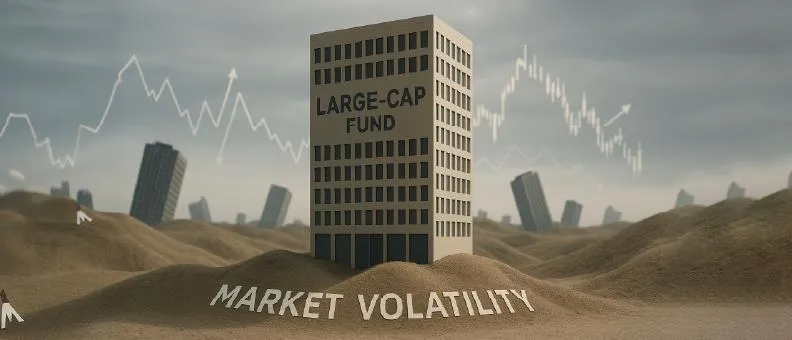Market volatility is a reality for every investor, and its effects can be both unsettling and confusing. While large cap funds are often seen as relatively stable during turbulent times, their behaviour during volatility deserves a closer look. Understanding how these funds respond, what triggers market swings, and how you can navigate this phase is crucial if you are potentially looking to build wealth with relatively lower risk.
Table of contents
What triggers market volatility?
Market volatility is typically sparked by a combination of economic, political, and global factors. News such as changes in interest rates by the Reserve Bank of India, corporate earnings announcements, geopolitical tensions, or unexpected global events like pandemics can quickly shift investor sentiment.
Even domestic occurrences––whether it may be a change in policy, a budget announcement, or fluctuations in rupee value versus key currencies ––can lead to amplifying market movements. Volatility increases as uncertainty creates reactions that leads to instantaneous buying or selling decisions. However, while volatility can create stress, it can also present potential opportunities for committed investors with a long-term focus.
Characteristics of large cap funds in volatile markets
Large cap funds invest predominantly in companies with large market capitalisations, often leaders in their respective sectors. These companies generally have diverse products, stable balance sheets, and recognisable brands. In more volatile markets, large cap funds may display a relatively lower price change versus a mid cap or small cap fund, chiefly because the underlying companies may have the scale and financial resources to accommodate short-term interruptions.
These funds often prioritise mitigating volatility impact on capital and may focus on blue-chip stocks that have a history of weathering economic cycles. However, while they may be less volatile, they are not immune to market swings and can still see potential declines during sharp corrections.
Read Also: Difference Between Large Cap, Mid Cap, and Small Cap Funds
How market volatility impacts large cap fund returns
During market turbulence, large cap fund returns may experience short-term declines, especially when the broader market faces widespread sell-offs. The impact, however, is often relatively less pronounced compared to other categories, as investors tend to gravitate towards companies perceived as relatively stable.
In phases of heightened volatility, large cap funds may underperform when the market rallies sharply—since smaller companies might rebound faster due to their higher risk-reward profile.
On the other hand, when markets fall, large cap funds often cushion the downside owing to the relatively steady performance of their holdings. Over time, this can help smooth out the potential portfolio returns, which may be favourable for investors with a moderate risk appetite.
Comparing large cap funds to mid cap and small cap funds during volatility
When market uncertainty increases, mid cap and small cap funds generally experience sharper fluctuations in their net asset values. These funds invest in companies with smaller market capitalisations, which are more sensitive to economic changes and liquidity concerns.
Large cap funds, in contrast, invest in established companies that may have better access to capital and typically more stable earnings. As a result, large cap funds tend to offer a more predictable performance curve during volatile periods.
If you are seeking relatively less price movement in your mutual fund portfolio during unpredictable times, large cap funds may be potentially more suitable compared to their mid and small cap counterparts.
Strategies to manage volatility when investing in large cap funds
Managing volatility in large cap funds starts with setting realistic expectations. You may want to:
- Continue regular investments: Systematic Investment Plans (SIPs) allow you to invest fixed amounts at regular intervals, averaging out your purchase cost over time.
- Diversify across asset classes: Spreading investments across equity, debt, and gold funds can help mitigate overall portfolio risk.
- Monitor asset allocation: Adjust your portfolio if your risk profile or financial goals change, especially during prolonged volatile periods.
- Avoid emotional decisions: Reacting impulsively to short-term market movements may lead to missed potential gains or locking in losses.
- Review fund performance periodically: Focus on long-term performance rather than short-term fluctuations, and compare your fund’s consistency against benchmarks.
- Consult a financial advisor: If market swings make you uncomfortable, seeking professional advice may help align your investments with your risk tolerance and goals.
Historical performance of large cap funds in volatile phases
Looking at previous episodes of market volatility, such as the market corrections in 2008, 2013, and 2020, large cap funds have generally demonstrated resilience compared to funds focused on smaller companies. While short-term declines were inevitable, the recovery for large cap funds was often steadier as the market stabilised. This is largely due to the presence of blue-chip stocks with strong fundamentals.
However, it is important to remember that past performance may or may not be sustained in future, as market conditions and fund management styles can evolve over time.
Read Also: Understand and Analyse Returns in Large and Mid Cap Fund
Expert tips for investing in large cap funds during market swings
- Stay disciplined: Stick to your investment plan and avoid making hasty decisions based on market panic.
- Focus on quality: Prioritise funds that consistently invest in financially sound, well-managed large cap companies.
- Rebalance, don’t react: Instead of exiting during downturns, consider rebalancing your portfolio to maintain your preferred asset mix.
- Leverage SIPs: Regular investing can help you benefit from rupee cost averaging, particularly during volatile phases.
- Keep a long-term view: Volatility is a part of the investment journey. Staying invested for the long haul may help realise the potential benefit of compounding and market recovery.
Should you invest in large cap funds when markets are volatile?
Investing in large cap funds during volatile times can be suitable if you prefer relatively less fluctuation in your portfolio and have a medium to long-term horizon. These funds may offer a balance between potential wealth creation and relative stability. However, it is important to note that no investment is completely risk-free. Your decision to invest may depend on your risk tolerance, investment horizon, and financial objectives. If you are looking to mitigate overall portfolio volatility while still having exposure to equities, large cap funds can play a key role in your asset allocation strategy.
Conclusion
Dealing with market volatility can be difficult and confusing but educating yourself about the performance of large cap funds in these environments could make it easier to act deliberately rather than reacting impulsively. Large cap funds (like all equity categories) feel the effects of swings in the equity market, but generally offer relative steadiness in how they behave compared to other equity categories. Focusing on quality, maintaining a disciplined approach, and investing based on your objectives will make navigating periods of market turbulence easier. Keep in mind that the wealth creation journey is more like a marathon than a sprint, and making peace with the notion of volatility as part of the investing process can help make you stronger as an investor.
FAQs:
How does market volatility affect large cap funds?
Market volatility can cause large cap funds to experience short-term declines as investors react to economic news or uncertainty. However, these funds usually invest in established companies with stable earnings and solid balance sheets, which can potentially help cushion the impact. While you may see fluctuations in your portfolio’s value, the overall effect of volatility is often less severe compared to funds focused on smaller companies.
Are large cap funds stable investment during volatile markets?
Large cap funds are widely considered relatively less volatile than other equity funds, especially during turbulent market conditions. This is because they primarily invest in companies that have the financial strength to weather economic downturns. While returns may not be guaranteed, these funds may be suitable for investors who seek a balance between potential wealth creation and relative stability
Can large cap funds provide stable returns in uncertain times?
Large cap funds may help in smoothing out returns during uncertain periods due to their focus on blue-chip companies. While they are not immune to market corrections, their underlying stocks typically tend to recover faster and with relatively less turbulence compared to mid cap and small cap stocks. However, it is important to have a long-term perspective and not expect immunity from all market swings.
What is the risk level of large cap funds during market fluctuations?
The risk level of large cap funds during market fluctuations is generally lower than that of mid cap and small cap funds. However, they are still subject to equity market risks, and their value may go down during sharp corrections. If you have a moderate risk appetite, large cap funds may be a suitable choice for managing volatility in your portfolio.
Should I pause my SIP in large cap funds during a market crash?
Pausing your SIP during a market downturn may not always be the best course of action. By continuing regular investments, you can take advantage of lower NAVs and potentially benefit from rupee cost averaging. Over the long term, staying consistent with your SIPs may help you accumulate more units and potentially enhance wealth creation when markets recover. However, you may want to review your SIP only if your financial situation or goals have changed.


